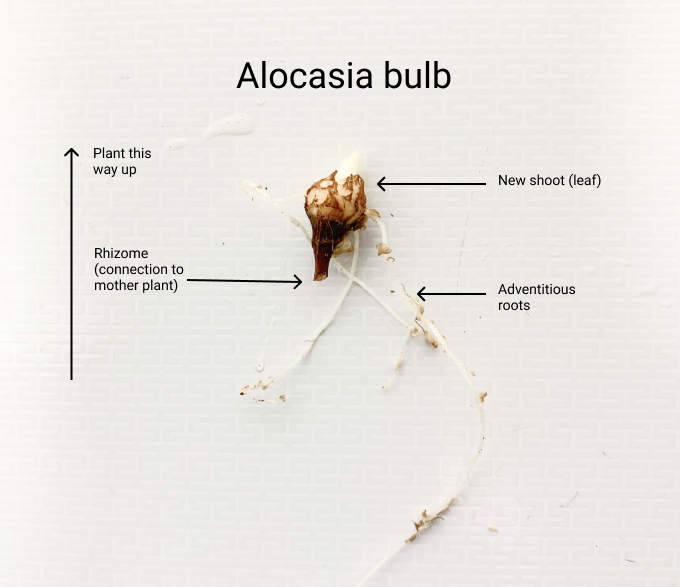Alocasia California, also known as Elephant Ear plant, is a popular houseplant cherished for its lush, tropical foliage. As a gardener, understanding the anatomy and function of this plant’s roots and stems can help you provide better care for your Elephant Ear. In this article, we’ll take a deep dive into the structure and purpose of the Alocasia California’s below-ground and above-ground organs.
An Overview of Alocasia California
Alocasia California belongs to the Araceae family, which includes other common houseplants like Monsteras and Philodendrons. Native to tropical Southeast Asia, these plants are characterized by their large, heart-shaped or arrowhead-shaped leaves on long, erect stems.
In the wild Alocasia California grows in humid, densely shaded areas and develops extensive root systems to maximize water and nutrient absorption. The fleshy stems store water and food reserves allowing the plant to survive dry periods.
When grown as houseplants, Elephant Ears stay much smaller but require similar care to mimic their native environment.
The Fibrous Root System
One of the defining features of Alocasia California is its fibrous root structure. This means the roots are thin, hair-like strands that branch out from the base of the plant.
The thin, delicate roots grow mostly horizontally, spreading out shallowly in the potting mix. This allows the plant to efficiently absorb moisture and nutrients from a large surface area.
Alocasia California lacks a strong taproot So the extensive network of fine feeder roots helps anchor the plant in place
Interestingly, the fibrous roots have specialized tissue that allows them to store water, much like miniature underground reservoirs During droughts, the Alocasia can draw from these reserves to keep its leaves hydrated
Roots Provide Nutrition and Support
The fibrous roots perform several essential functions that are key to the plant’s survival:
- Absorb water and dissolved minerals from the soil.
- Transport moisture and nutrients to the rest of the plant.
- Store water and food reserves during dry periods.
- Anchor the plant securely into the ground.
- Prevent soil erosion with their dense network.
In essence, a healthy root system lays the foundation for vigorous vegetative growth and the plant’s overall health.
The Unique Stem Structure
In botany, the portion of the plant between the roots and the leaves is called the stem.
The stems of Alocasia California are stout, upright, and unbranched. They emerge directly from the corm-like bulb at the base.
The stems are notable for their succulent, fleshy texture. Unlike woody stems, they lack hard lignified tissue and are soft and pulpy inside. They act as reservoirs, storing moisture and nutrients.
Chlorophyll in the outer layers of the stem allows it to perform photosynthesis and produce energy. But its primary role is providing structural support for the large leaves.
Stems Transport Resources and Store Reserves
The stem’s anatomy directly ties into its functions:
-
Acts as a conduit between the roots and leaves, transporting water, minerals, and sugars.
-
Provides structural support for leaves, flowers, and fruit.
-
Stores nutrients, water, and carbohydrates as backup reserves.
-
Produces energy through photosynthesis.
-
Can produce new plants through vegetative propagation if cut.
Caring for Your Alocasia California
Now that you understand how the roots and stems function, you can provide better care for your Elephant Ear houseplant.
Here are some key tips:
-
Water thoroughly when the top inch of soil dries out to keep the roots hydrated.
-
Mist frequently to maintain high humidity around the leaves.
-
Fertilize regularly during the growing season to replenish nutrients.
-
Repot annually in fresh, nutrient-rich potting mix.
-
Prune away any damaged or diseased stems.
-
Propagate new plants by dividing the roots or taking stem cuttings.
The Bottom Line
The anatomy and physiology of Alocasia California is quite fascinating for houseplant enthusiasts. The fibrous roots maximize moisture and nutrient absorption. The succulent stems transport resources while storing backup reserves.
Understanding these key organ functions will help you make informed care decisions to keep your Elephant Ear thriving beautifully in your home.

k
Plant Anatomy and Structure
FAQ
What is the root system of Alocasia?
What are the balls in Alocasia roots?
What is the function of Alocasia?
What are some interesting facts about Alocasia?
Can Alocasia be propagated from seed?
Alocasias can be propagated from “seeds” in the soil called corms! They are typically found in more mature plants but may pop up in younger ones. Check out Propagation 101 for the how-to! Alocasias are striking additions to any indoor garden.
How do you grow Alocasia?
These tips will help you grow any variety. It can differ between types, but most alocasia plants grow best in moderate to bright indirect light. Give them plenty of diffused sunlight, but keep them out of direct sun, which can burn the leaves. Low light will slow or stunt leaf growth.
When do Alocasia flowers appear?
Alocasia can produce small, spathe-like flowers when given the proper care, even indoors. The blossoms appear on their own stems in mid to late summer. But they are usually fairly insignificant, and commonly hidden by the dominant foliage, so you may not notice them.
What temperature should alocasias grow?
Alocasias are warm-growing plants, and prefer a temperature range between 65-85 degrees F (18 -20 degrees C). Temperatures at 60 degrees F (15 degrees C) and below may cause your plant to drop its leaves and enter dormancy. Photo by Severin Candrian on Unsplash. Website: feey.ch
